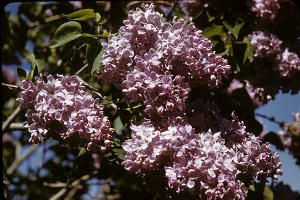Although Syringa vulgaris is native to southeastern Europe, it has been naturalized in many other regions of the globe.The plant has been used ethnobotanically to reduce fever and treat malaria, as a perfume and a tonic, and in homeopathy.
Photo Credit: © R.A. Howard. Courtesy of Smithsonian Institution, Dept. of Systematic Biology, Botany.
Syringa vulgaris
Common Name: common lilac
Plant Functional Group: Deciduous broadleaf
Class > Order > Family: Magnoliopsida > Lamiales > Oleaceae
What does the species look like?
Common lilac is an introduced, perennial, deciduous shrub that grows between 12 to 16 feet tall. The flowers are mostly white, lilac, or purple, and pleasantly fragrant in long terminal panicles.
Common lilacs (also called "hedge" or "old-fashioned") are often sold in nurseries or are found already growing on homesites. They have leaves that are somewhat heart-shaped and are much wider than the leaves of cloned lilacs.
Where is the species found?
States & Provinces
AR, BC, CO, CT, DC, IA, IL, IN, KS, KY, MA, MD, ME, MI, MN, MO, NB, NC, NH, NJ, NS, NY, OH, ON, OR, PA, PE, QC, RI, SD, SK, TN, UT, VA, VT, WA, WI, WV
Special Considerations for Observing
When to Start Observations: In the middle of winter, lilac buds are desiccated (dried out) and appear somewhat shriveled (mid-winter bud ). In late winter, after conditions begin to warm, the buds hydrate (swell due to becoming moist), and the tips open slightly (late winter bud ). The best way to know when to start looking for the first emerging leaves is to watch for these two events. Once the buds have swelled and the bud ends are slightly open and a bit green, the next round of warm weather can force the first leaves to emerge.
Monarch Watch participants should observe the "open flowers" phenophase.
Which phenophases should I observe?
Do you see...?
Leaves
Breaking leaf buds
View Phenophase Image (This phenophase was previously called "First leaf".) More...
All leaf buds broken
View Phenophase Image (This phenophase was previously called "Full leaf out".) More...
Flowers
Open flowers
View Phenophase Image (This phenophase was previously called "First bloom".)
Full flowering
View Phenophase Image (This phenophase was previously called "Full bloom".)
End of flowering (This phenophase was previously called "End of bloom".) More...
What do these phenophases look like?
The following Phenophase Photo Guides for this species have been vetted for accuracy by the USA-NPN National Coordinating Office. Most photo guides are developed for a particular local or regional monitoring effort, and some of the content may not apply to your effort or your region. However, we make them available to provide as much help as they may in illustrating phenophases for this species. If you have high quality phenophase photos that you are willing to share with us, please visit the Phenophase Photo Guidelines page.
Be aware there is variation from individual to individual within a species, especially across different regions, so your plant may not look exactly like the one pictured.
Since they do not always include complete definitions for the species, use these photo guides ONLY in conjunction with the official Nature's Notebook phenophase defintions included in the table above, in the phenophase definition sheet that downloads with the datasheet, or in the Observe screen in the mobile app.
